39 Chihuahua Colors & Patterns
August 15, 2021 2021-08-15 14:57The world of Chihuahuas is one of the most colorful in the dog world. While the kennel clubs only recognize a few colors in certain breeds, when it comes to Chihuahuas, they welcome a veritable chocolate box of colors with open arms.
The American Kennel Club (AKC) is, somewhat uncharacteristically, laidback about the Chihuahua’s colors, and its breed standard says nothing more than, “Any color – Solid, marked or splashed.”
If you want to register a Chihuahua, the AKC lists 9 standard colors and 21 additional colors, combinations, and patterns, each with its own registration code. Neither the Fédération Cynologique Internationale (FCI) nor the United Kennel Club (UKC) give Chihuahuas quite such a free reign, with both listing the merle coloration as unacceptable.
The Chihuahua’s complex history is, no doubt, at least partly responsible for the breed’s wide array of colors and patterns. Regardless of whether the Chihuahua descended from the Mexican Techichi or a breed of European dog introduced by the colonists, it certainly has a colorful past!
As we have an entire rainbow of Chihuahua colors to get through, let’s start with the five most common.
Table of Contents
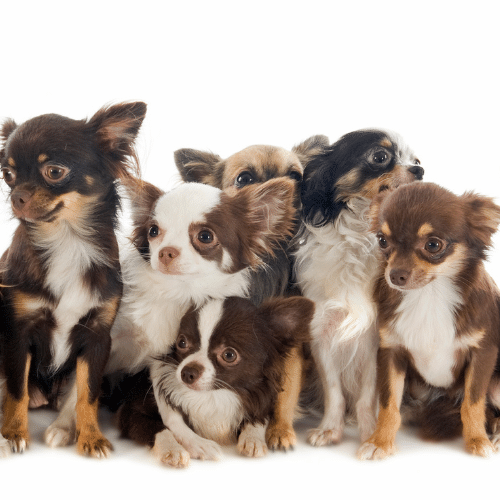
The 5 Most Common Chihuahua Colors?
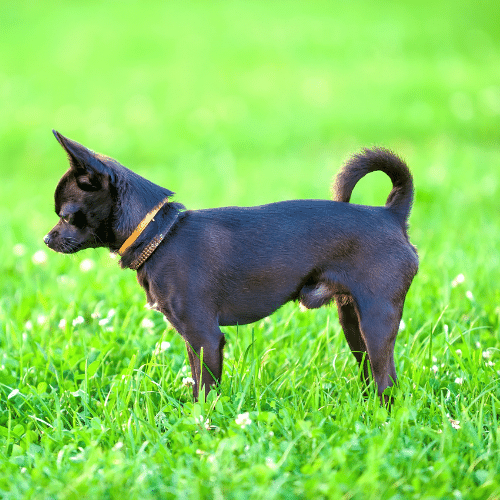
#1 Black
It may seem strange to start a list of the most common colors with one of the rarest but, there is method in my madness! Pure black Chihuahuas are so rare you’ve probably never even seen one.
Despite this, black is, genetically, the most dominant color in Chihuahuas so, is relatively widespread, it’s just usually accompanied by a few splashes of white or another color.
Although there are “at least three dominant genes that result in solid black,” because they are dominant, they’re easier to breed out than recessive genes, which is why a pure black Chihuahua is such a rare sight.
Black is an acceptable color for both short and long-haired Chihuahuas, and even some hairless Chihuahuas may be predominantly black.
#2 Chocolate
Chocolate is rarely an acceptable color for dog breeds because it comes from a dilute gene that washes out the black pigmentation.
Fortunately for chocolate Chihuahua lovers, it’s an acceptable color even if it doesn’t appear particularly popular amongst breeders.
For a Chihuahua to be considered a true chocolate, it should have a darker coat than those categorized as either brown or liver, although some splashes of white or another color are also acceptable.
Because a dilute gene is responsible for the chocolate color, these Chihuahuas usually have brown or beige noses rather than the standard black.
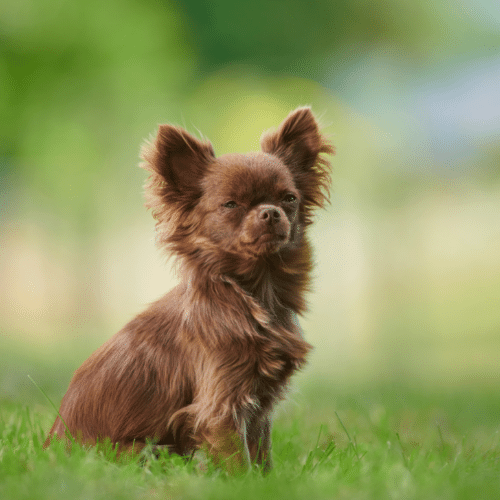
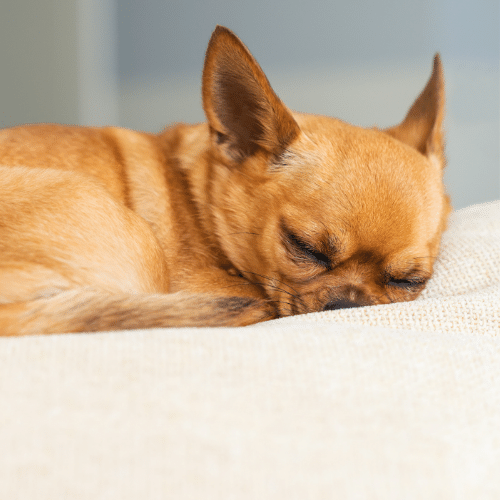
#3 Red
The Pheomelanin pigment is responsible for the redness in a Chihuahua’s coat and, depending on the genetic interactions of the parents, can produce a range of colors. Some Chihuahuas of this color are a rich reddish-brown, almost the color of mahogany, while others have bright red coats interspersed with darker hairs.
As this pigment only influences the color of the coat and not the skin, most red Chihuahuas have black noses, paws, and eye rims.
#4 Fawn
When you picture a Chihuahua in your mind, your first instinct is probably to conjure up an image of a small, yellowish dog with big ears. This is because the fawn Chihuahua is one of the most common. In the past, the Chihuahua was referred to as a “little yellow dog” so, this is clearly a color that has dominated the breed for some time.
There has been some confusion surrounding the fawn Chihuahua, with some mistaking it for a specific and distinct type. This could be due to the popularity of the deer-head Chihuahua, which has a V-shaped head as opposed to the standard “apple dome” skull specified by the AKC breed standard. A fawn Chihuahua only resembles a baby deer, or fawn, in its coloration, however, and isn’t easily confused with Bambi!

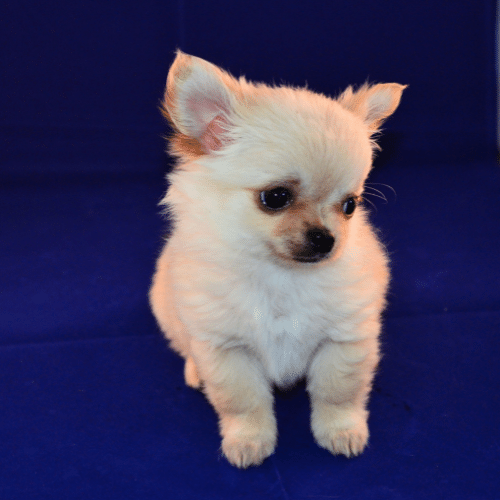
#5 Cream
Cream Chihuahuas can appear almost white but, all retain some red in their coats, giving it a faintly apricot tinge that creates the creamy hue. Many cream Chihuahuas have pale skin but, most have black noses and eye rims.
Chihuahuas often change color as they mature so, a puppy that appears to be pure white may develop a beige tinge as it gets older, which could be disappointing for a breeder looking to create the rare yet eye-catching white Chihuahua.
Other Solid Colors Do Chihuahuas Come In?
In addition to the five most common colors, Chihuahuas can come in any of the following shades, with or without patterning:
#1 Blue
Although blue is a relatively common color in some breeds of dogs, in Chihuahuas it’s extremely rare. You can only breed a blue Chihuahua puppy from two parents, which carry the same recessive gene that dilutes the black pigmentation.
Breeding for a recessive gene is widely considered unethical as it reduces the gene pool, leading to potential defects down the line.
Despite this, blue Chihuahua puppies are in such demand, breeders charge as much as $10,000 for a tiny blue puppy!

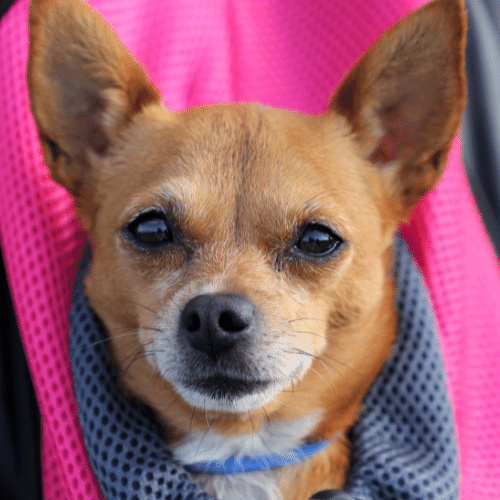
#2 Gold
Like red, gold is produced by the red Pheomelanin pigment. Ranging from an almost creamy color to a golden brown, gold Chihuahuas are not the same thing as golden Chihuahuas which are a rather mind-boggling cross between the Golden Retriever and the Chihuahua.
Depending on the type of Eumelanin pigment, a gold Chuhuha may have either a black or liver-colored nose.
#3 Silver
Like the blue color in Chihuahuas, silver is the product of the recessive dilution gene (dd). Some argue that “the silver Chihuahua isn’t really silver at all,” saying that it’s merely a combination of gray and white hairs that gives them that distinctive “metallic appearance.”
Despite that, silver is listed as an accepted color of Chihuahua and even has its own registration code, which suggests that breeders either believe it exists or that they prefer to spice up a grayish color coat by giving it the more exotic title of silver.
Silver (sometimes under different names) is seen in several other dog breeds, such as Weimaraners, Border Collies and Fluffy Frenchies.
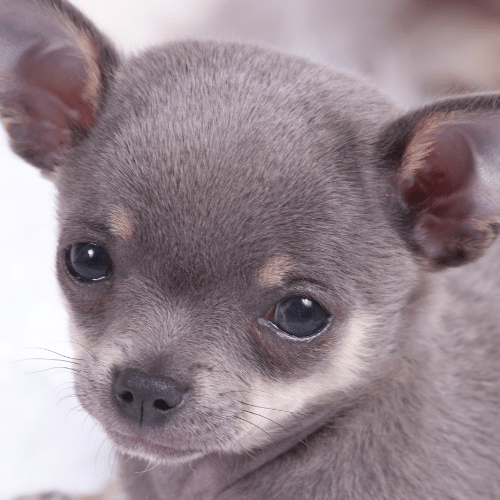

#4 White
White is, arguably, the rarest color of Chihuahua around. An albino Chihuahua isn’t the same thing as a white one, but both are the result of a lack of pigmentation. The white Chihuahua lack melanocytes, which give the coat its pigmentation, but retain the eumelanin needed to give them black eyes, noses, and paws. In some instances, however, they may have pink noses, like Demi Moore’s Chihuahua, Vida.
#5 Chocolate Blue
I hesitated before including this color as it is not widely recognized by breeders. I decided to put it in, however, as it is listed by the AKC.
To get a chocolate blue puppy, you would need to have parents that carried both the dilute gene for black pigmentation – to produce the blue hue – and the ‘b’ allele that makes black pigment appear brown. I’m not a genetic expert so, have no idea whether that combination is even possible but, if the AKC says it is, I guess we’ll take their word for it.
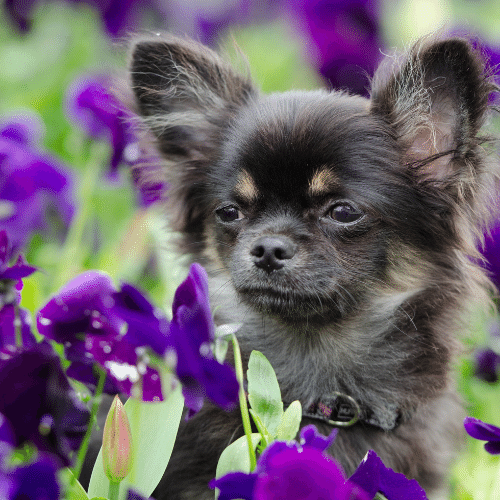
Color Combinations Of The Chihuahua
Chihuahuas are such a mixed bag when it comes to color that these nine solid colors are just the beginning. Chihuahuas with two different colors in their coats are often very striking, so much so that, during the Nineties, pop queen Madonna was often seen in the company of a little black and tan Chihuahua.
Let’s take a look at some of the most common and eye-catching color combinations taking to the Chihuahua catwalk this year.
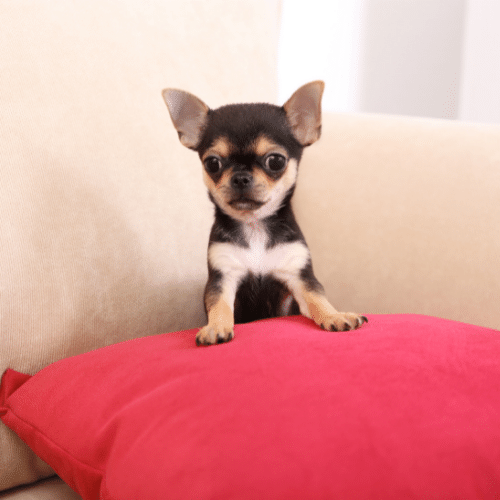
#1 Black & Tan
Black and Tan Chihuahuas are among my favorites but, they’re not particularly common. To get those tan markings on the paws and chest, a puppy must have a very specific combination of alleles, namely “a double non-black allele (kyky) in the K locus and… at least one tan-point allele (at) in the Agouti (A) locus.”
Many black and tan Chihuahuas also have a white marking here and then, most commonly on the chest. Because it reminds of the traditional coloring of the Doberman, these Chihuahuas are sometimes referred to as “Mini Dobies”.
#2 Blue & Tan
Another rare color combination, the blue and tan Chihuahua needs the same alleles as the black and tan, the other difference being that it also requires the dilution gene that fades the black pigmentation to blue.
Depending on the extent of that dilution, the blue parts of the coat can range from charcoal grey to almost powder blue. The tan coloring usually occurs on the paws, around the muzzle, and the tips of the ears.
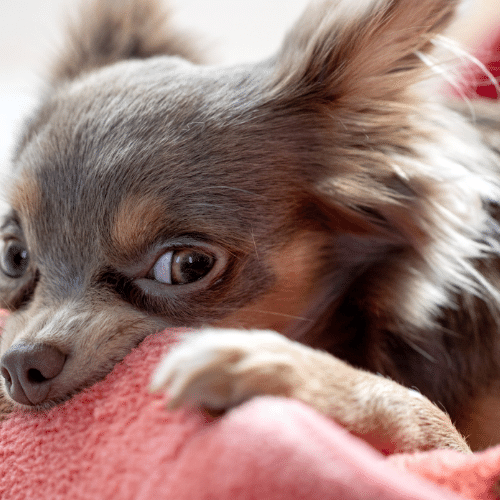
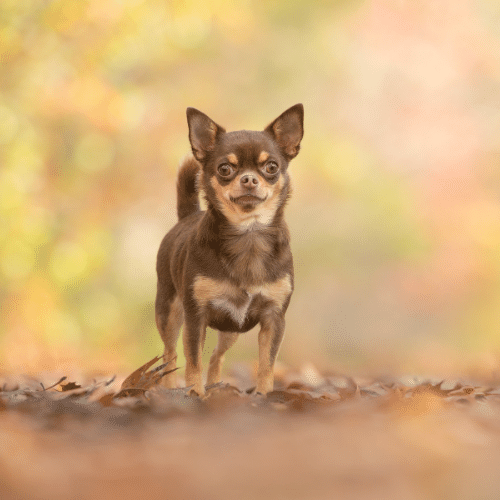
#3 Chocolate & Tan
Although chocolate isn’t a particularly rare color when it comes to Chihuahuas, the combination of chocolate with another color, such as tan, is fairly uncommon. To get this color combination, a puppy must have the tan-point allele in the Agouti gene and mutations in the B locus.
The result can be almost majestic but, as it’s rare, a chocolate & tan Chihuahua puppy could cost as much as $1,500, as opposed to the more reasonable price tag of $500 to $1,000 for a more standard color.
#4 Fawn & White
Chihuahuas with more than one color in their coats usually wear the darker one on top and the lighter one on the chest, face, muzzle, toes, and belly. This is true of the fawn and white Chihuahua, although it can be difficult to distinguish the two colors on very light fawn puppies.
Fawn & white Chihuahuas can have either liver or black noses, depending on their specific genetic make-up.
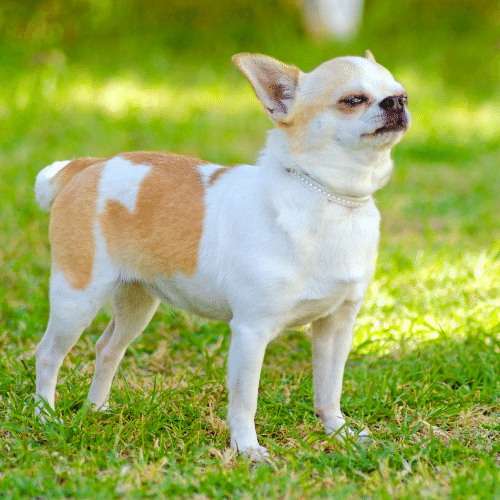
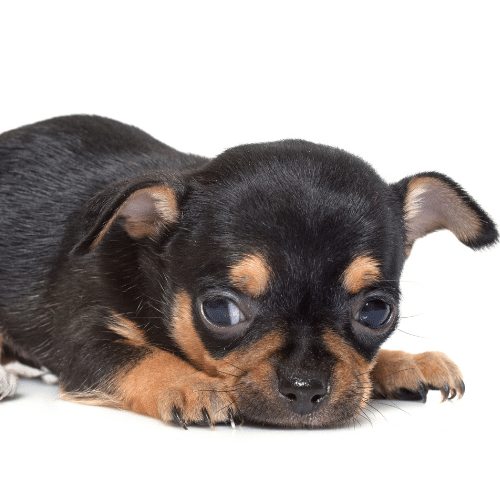
#5 Black & Red
The combination of black and red is more commonly seen on a Rottweiler or German Shepherd, but those Chihuahuas lucky enough to wear it, carry it off with considerable style.
Although similar to the black and tan combination, the darker shade of red visible in the black and red coat makes it relatively easy to distinguish the two.
#6 Black & Silver
The intensity of the silver points makes a black & silver Chihuahua stand out from the crowd. It’s not a particularly common combination as it requires a dilution of the black pigmentation to coexist with a solid black base coat.
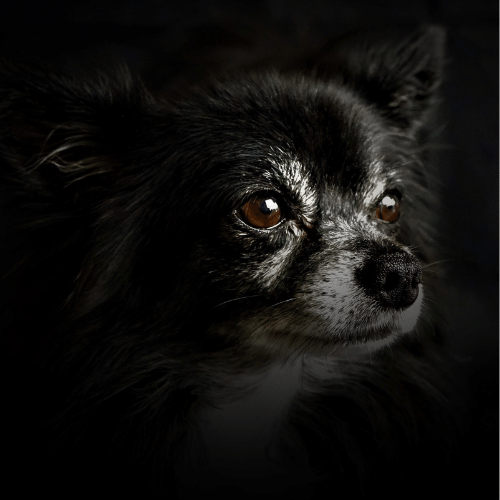
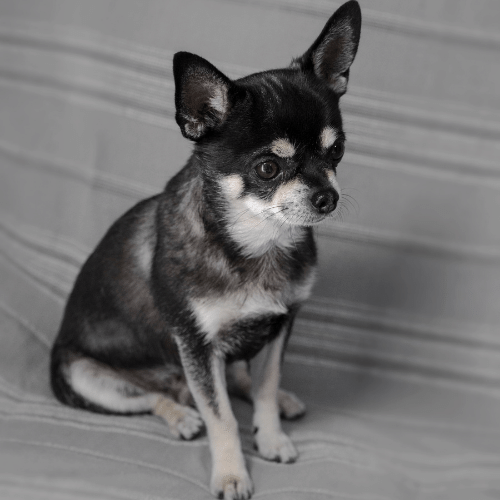
#7 Black & White
Some breeds of dog are almost always black and white, like the Border Collie for instance, and it’s not uncommon among Chihuahuas either. While the eumelanin pigment is responsible for the black coloration, the white parts lack any pigmentation at all.
Although the black and white Chihuahua is appealing to look at, he may suffer as a consequence of his two-toned coat. Research indicates that piebald and white dogs are more likely to suffer congenital hearing loss than dogs of other colors.
Having said that, the famous paraplegic Chihuahua from Long Beach, Wheely Willie, never showed any signs of deafness. With his K-9 Cart, this little guy became an ambassador for people with physical disabilities before he passed away in 2009.
#8 Blue & White
With the dilution allele creating the blue coat, these Chihuahuas may have little more than a splash of white on the chest. With blue being a rare color, these multicolored dogs are highly sought after, which often means an overly inflated price tag.
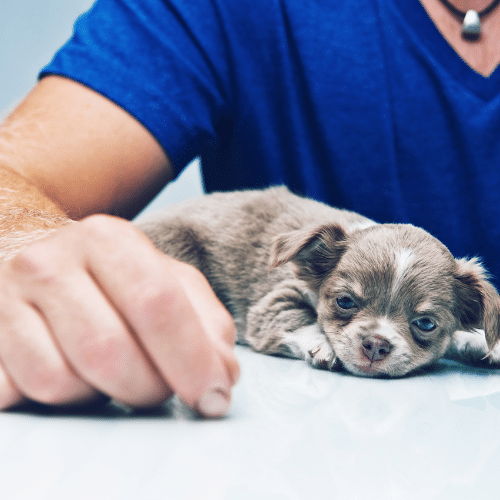

#9 Chocolate & White
This adorable combination gives the impression of a pup make out of milk and white chocolate. With their white paws and chests, the chocolate and white Chihuahua is one of the most irresistible.
The chocolate hue is influenced by a mutation in the black gene, while the white parches are the result of an absence of pigment cells.
While most chocolate & white puppies have small amounts of white on them, they can take on an almost particolored pattern.
#10 Gold & White
Another eye-catching combination, the gold, and white Chihuahua can be primarily gold with a white tip on its tail and paws, or it can be particolored, with white patches all over. Some of the most striking gold and white Chihuahuas feature “Irish spotting” so, have white on the legs, tail, chest, neck, and muzzle.
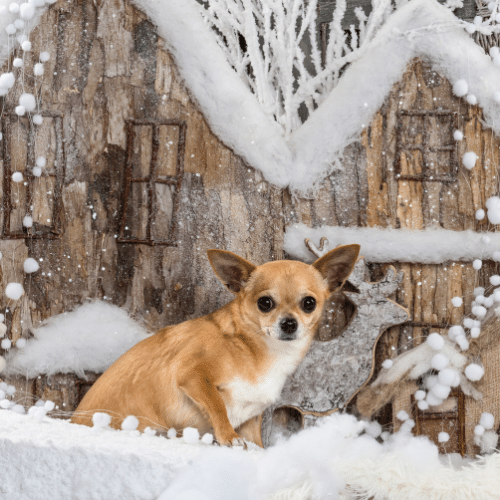
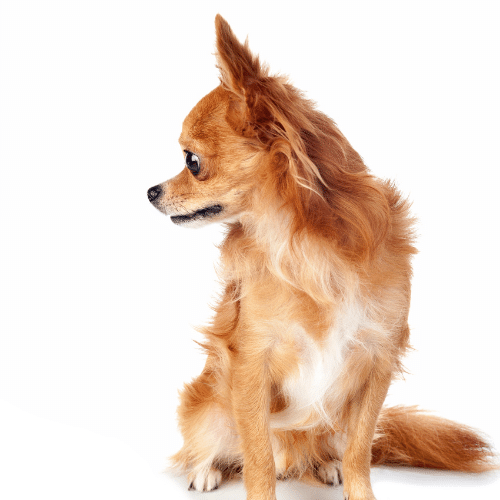
#11 Red & White
The red and white Chihuahua looks like a miniature Irish Setter. The long-haired versions carry this color combination off particularly well, whether they have a completely red body or are primarily white with a few red patches.
In addition to these 12 color combinations, the AKC also lists silver & white and cream & white as possible variations.
What Is The Perfect Pattern For A Chihuahua Puppy?
Having covered all the solid colors and basic color combinations, it’s time to move onto some of the most common and interesting patterns found in the Chihuahua. Again, these are widely varied and open to interpretation. While some consider there to be only one type of brindle Chihuahua, for instance, the AKC lists three different varieties.
#1 Sable
The sable pattern of a Chihuahua is the same as it is in any other breed of dog. While the tips of the hairs are black, the rest of the coat is predominantly silver or fawn. The AKC lists three varieties of sable Chihuahua – Black Sabled Fawn, Black Sabled Silver, and Chocolate Sabled Fawn.
Sable is a very dominant gene so, for a puppy to develop this pattern, it only needs one allele of sable.
It’s generally accepted that there are three different varieties of sable patterning, known as clear, tipped, and shaded. While Chihuahuas with a clear sable pattern will have black coloration throughout the coat, tipped sables usually display it only on the head, back, and tail. Shaded sables, meanwhile, have more brown or black hairs on the back and neck than the rest of the body.
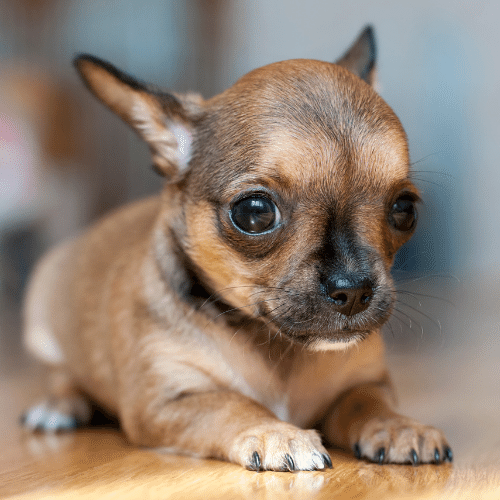

#2 Brindle
A tiny teacup Chihuahua with tiger stripes is quite possibly the most adorable puppy you’re likely to come across. The brindle pattern, caused by “by the Kbr allele in the Dominant Black (K) locus,” is fairly rare in Chihuahuas, despite being common in other breeds, like the Pit Bull, for instance.
The AKC has distinct registration codes for three different types of brindle – blue brindled fawn, chocolate brindled fawn, and fawn brindled black, which some may refer to as reverse brindle.
As brindle Chihuahuas are comparatively rare, some breeders may charge more for these multi-colored pups, even asking as much as $3,000. This could be a huge waste of money as Chihuahuas often change color as they mature so, those tiger stripes you just paid for could disappear within a year!
#3 Merle
Merle markings are included in the AKC’s registration codes but are grounds for disqualification according to the UKC. This unusual patterning is also actively discouraged by the Chihuahua Club of America.
Although the mottled or dappled design is striking and often offset by blue or different colored eyes, the coloration is also linked to certain health problems and genetic complications.
As the “merle coloring does not occur naturally in Chihuahua DNA,” the only way for a merle Chihuahua to exist is if it has inherited genes from another breed of dog. In other words, a merle Chihuahua is not a purebred dog which is why the kennel clubs are so opposed to it.
Another problem with the merle Chihuahua is that the merle gene lightens and whitens its pigmentation, causing the pigment in the ears and eyes to whiten, as well. It’s this process that’s responsible for the blindness and deafness so often found in merle Chihuahuas.
Although some merle puppies may appear healthy, if they’ve inherited a double merle genotype, they may experience problems with their cardiac, reproductive, and skeletal systems later in life.
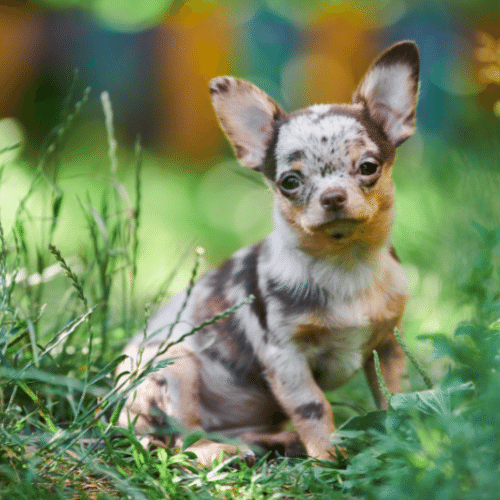
A Summary Of The 39 Colors And Patterns Of The Chihuahua Rainbow
- Black
- Black & Tan
- Black & Red
- Black & Silver
- Black & White
- Black Sabled Fawn
- Black Sabled Silver
- Black Brindling
- Black Mask
- Black Sabling
- Black Mask, White Markings
- Blue
- Blue & Tan
- Blue & White
- Blue Mask
- Blue Brindled Fawn
- Brown
- Chocolate
- Chocolate Blue
- Chocolate & Tan
- Chocolate Brindled Fawn
- Chocolate Sabled Fawn
- Cream
- Cream Markings
- Cream & White
- Fawn
- Fawn Brindlled Black
- Fawn Markings
- Gold
- Gold & White
- Merle Markings
- Red
- Red & White
- Red Markings
- Silver
- Silver & White
- Spotted on White
- White
- White Markings
What Is The Rarest Chihuahua Color?
There are a few colors that you won’t come across very often in the Chihuahua, including merle, blue, and chocolate blue. All these, however, are more common than a pure white Chihuahua. The only way to get a snow-white puppy is to breed two white parents.
To be considered a white Chihuahua, the dog must have no black pigment to his skin whatsoever. As a result, most white Chihuahuas have pale-colored eyes, a pink or tan nose, and white nails, as do many fawn and cream pups.
What Colors Are Most Chihuahua?
The most common colors of Chihuahua are black, brown, cream, fawn, and red.
How Much Does A Chihuahua Puppy Cost?
The average cost of a Chihuahua puppy is between $500 and $1,500, depending on its color and breeding. A dog with champion bloodlines may fetch as much as $4,000 which is still a drop in the ocean when compared with how much it costs to keep one of these little critters.
What Is The Most Expensive Breed Of Dog To Own?
Research shows that Chihuahuas are the most expensive breed of dog to own, costing their owners over $117,000 during their 12-20-year lifespan.
Admittedly, this isn’t primarily the fault of the dog but rather the owner. Apparently, Chihuahua owners are more likely to buy fresh meat and vegetables for their dog’s dinner and “have a pronounced weakness for costly jeweled collars for their pets, designer doggie outfits, and bespoke beds.”

Author: Nicky Hoseck
Nicky lives on a small-holding on South Africa’s Wild Coast with a selection of animals, a husband, and five dogs. She spends all her waking hours with her Australian Cattle Dog, Koala, either walking, horse-riding, running, or just hanging out.
Originally from the UK, Nicky been living with dogs for over 40 years and is a passionate dog-owner.
With a Masters Degree from the University of London under her belt, Nicky has had a diverse career, training and riding horses, running safari lodges, and hosting volunteers. She’s now a full-time writer.

